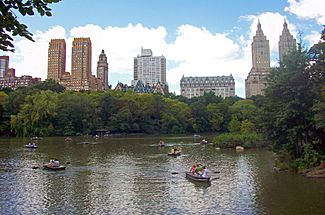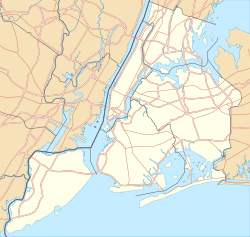Central Park West Historic District facts for kids
The Central Park West Historic District is a special area in Manhattan, New York City. It runs along Central Park West between 61st and 97th Streets. This district was added to the National Register of Historic Places on November 9, 1982.
It's part of a larger area called the Upper West Side-Central Park West Historic District. This larger area was chosen by the New York City Landmarks Preservation Commission. The district includes many famous New York City buildings, like The Dakota Apartments, which is a National Historic Landmark.
The buildings in this district were built from the late 1800s to the early 1940s. They show off many different building styles. Most buildings here are in the Neo-Italian Renaissance style, which means "new Italian Renaissance." But you can also see many buildings in the Art Deco style.
Contents
History of the District
Most of the buildings in this historic district were built between the 1880s and the 1930s. This happened after Central Park was finished. It also got a boost from the Ninth Avenue Elevated train, which made it easy to travel to Lower Manhattan.
At first, smaller apartment buildings called tenements and row houses were built on Amsterdam and Columbus Avenues. But on Central Park West, fancier, luxury buildings went up. The closer a building was to Central Park, the more expensive and grand it usually was.
By the early 1900s, many of the row houses were replaced with larger apartment buildings. The building of the New York City Subway's Eighth Avenue Line in the 1920s sped up this change.
The Central Park West Historic District was officially recognized by the U.S. government on November 9, 1982. It was added to the National Register of Historic Places. Before that, in 1973, the New York City Landmarks Preservation Commission (LPC) had already named a smaller part of the area as a historic district.
In 1990, the LPC made its local historic district much bigger. It now includes almost all the same area as the federal historic district. This larger area is called the Upper West Side-Central Park West Historic District. It stretches from 96th Street to 62nd Street and from Central Park West to Amsterdam Avenue.
Where is the District?
The Central Park West Historic District is a long, narrow area. It includes the part of Central Park West from 61st Street to 97th Street.
When the Upper West Side–Central Park West Historic District was named a local historic district in 1990, its borders were very similar to the 1982 federal district. However, the local district also includes land that goes all the way to Amsterdam Avenue. So, the federal historic district is quite a bit smaller than the local one.
Building Styles
Central Park West, between 61st and 97th Streets, shows off many building styles from the late 1800s and early 1900s. The most common style is Neo-Renaissance, especially the "new Italian Renaissance" look. But you can also see some German and Flemish Renaissance influences.
Other popular styles include Art Deco, Second Empire, Beaux-Arts, and Neoclassical architecture. You might also spot Gothic and Romanesque Revival influences mixed with other styles. A few Queen Anne, Art Moderne, and Italianate buildings also stand out along Central Park West.
Famous Buildings
Almost all the buildings in this historic district help tell its story. Only one building, at 80 Central Park West, built in 1965, was not considered part of the original historic character.
The district is home to nearly 40 tall, fancy apartment buildings. You'll also find four Christian churches, one synagogue, some smaller multi-family houses, the New York Society for Ethical Culture, the New-York Historical Society, and the American Museum of Natural History.
Here are some of the notable buildings:
- The Century (25 Central Park West): Built in 1931 in the Art Deco style. At 30 floors, it's one of the tallest buildings in the district. It was built where the Century Theatre used to be.
- Ethical Culture Meeting House (2 West 64th Street): Built in 1910 in the Art Nouveau style.
- Ghostbusters Building (55 Central Park West): This building is famous for being in the 1984 movie Ghostbusters. In the movie, it was called "Spook Central." In real life, this Art Deco building was built in 1929.
- Congregation Shearith Israel (8 West 70th Street): Also known as the Spanish and Portuguese Synagogue. Built in 1897 in the Classical Revival style. It is the oldest Jewish congregation in America.
- The Majestic (115 Central Park West): Built in 1930 in the Art Deco style. It's another one of the district's tallest buildings, at 30 floors.
- The Dakota (1 West 72nd Street): Built in 1884 in the German Renaissance style. Some people say it was the first luxury apartment building in New York City. It's a National Historic Landmark.
- The San Remo (145-146 Central Park West): Built in 1930 in the Classical Revival style. It's a well-known 27-story building with two towers.
- New-York Historical Society (170 Central Park West): Built in 1908 and 1938 in the Classical Revival style.
- American Museum of Natural History (79th Street at Central Park West): Built starting in 1877, with parts added in 1900. It shows Gothic Revival and Romanesque Revival styles.
- The Beresford (211 Central Park West): Built in 1929 in the Classical Revival style.
- The Eldorado (300 Central Park West): Built in 1931 in the Art Deco style. It's another 30-floor building, tying for the tallest in the district.
Why is it Important?
The Central Park West Historic District is important for its amazing architecture. It's also special because it's a strong, connected neighborhood. This area is along one of New York City's best residential streets. It has many of the city's earliest and finest apartment buildings.
When the local district was made bigger in 1990, the New York City Landmarks Preservation Commission said the district's strength was its variety. They called the buildings "commercial" and "stylistically diverse." The Commission also said that the buildings on Central Park West create a unique skyline that stands out in New York City. They said, "The stylistically diverse buildings of Central Park West create a streetscape and a skyline which is exuberant and varied as to scale, height and form."
See also
 In Spanish: Distrito histórico de Central Park West para niños
In Spanish: Distrito histórico de Central Park West para niños





